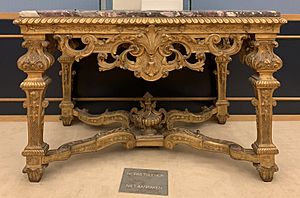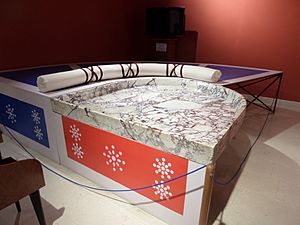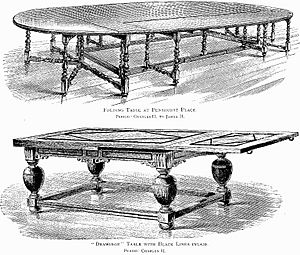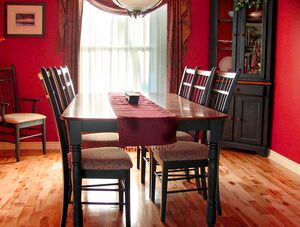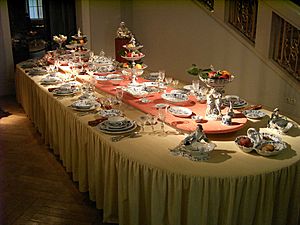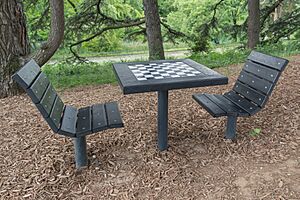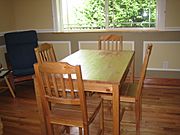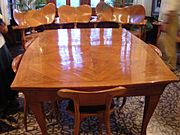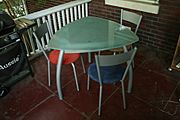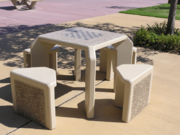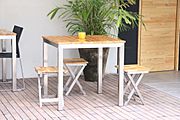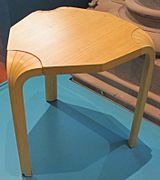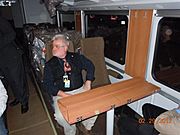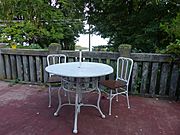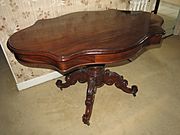Table (furniture) facts for kids
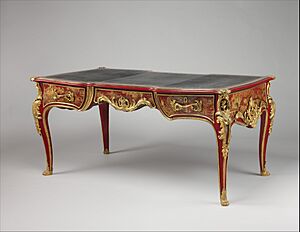
A table is a piece of furniture with a flat top surface. It usually has one or more legs to support it. People use tables for many things, like working, eating, or just putting items on.
Some common types of tables include:
- Dining room tables: These are used for people to sit and eat meals together.
- Coffee tables: These are low tables often found in living rooms. People use them to display decorations or serve drinks.
- Bedside tables: These small tables are placed next to a bed. They are handy for holding an alarm clock, a lamp, or other personal items.
There are also special tables for specific tasks, like:
- Drafting tables: Used for making architectural drawings.
- Sewing tables: Used for sewing projects.
Tables come in many shapes and sizes. Their tops can be rectangular, square, round, or even oval. Most tables have four legs, but some have three, a single central support, or are attached to a wall. Many tables can also fold up or have parts that extend to make them bigger.
Contents
What Does "Table" Mean?
The word table comes from an old English word, tabele. This word came from the Latin word tabula, which means 'a board' or 'flat piece'. The way we spell "table" today was influenced by the French word table.
A Quick Look at Table History
People have been using tables for a very long time!
- Ancient Egypt: Around 2500 BC, the Egyptians made early tables from wood and stone. These were often simple platforms to keep things off the floor. They also used small tables for games.
- Ancient Greece and Rome: The Greeks and Romans used tables more often, especially for eating. Their tables were made of marble, wood, or metal like bronze. Some had very fancy legs. The Romans even introduced a large, half-circle table called a mensa lunata.
- Middle Ages: During the Middle Ages, many tables were simple trestle tables that could be easily moved. This was important because people often traveled. Later, smaller round tables started to appear. Large, long tables called Refectory tables became popular in castles for big meals.
Table Shapes, Heights, and Uses
Tables are made from many different materials, like wood, metal, and glass. They come in all sorts of shapes and heights, depending on what they are used for.
- Common Shapes: The most common table top shapes are rectangular, square, round, and oval.
- Supports: Most tables have a flat top and one or more legs. A table with just one central leg is called a pedestal table.
- Adjustable Tables: Many tables can change their height or size. Some have parts that fold, slide, or extend. This makes them very useful for small spaces or when you need extra room.
- Folding Tables: Some tables can fold completely flat for easy moving or storage, like camping tables or TV trays.
- Wall Tables: Tables designed to sit against a wall are called Pier tables or console tables. They might be attached to the wall like a shelf or have legs.
Different Kinds of Tables
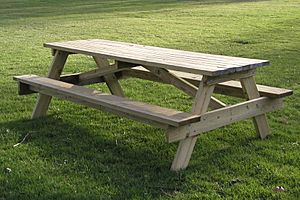
Here are some specific types of tables and what they are used for:
- Dining room tables: For eating meals, often with family and friends.
- Bedside tables (or nightstands): Small tables next to a bed for lamps, alarm clocks, or glasses.
- Drop-leaf tables: These tables have a fixed middle part and hinged sections on the sides that can fold down.
- Gateleg tables: Similar to drop-leaf tables, but their hinged leaves are supported by hinged legs.
- Coffee tables: Low tables in living rooms, placed in front of sofas for drinks, books, or decorations.
- Refectory tables: Long tables designed to seat many people for large meals.
- Drafting tables: Tables with tops that can tilt, used for making large or technical drawings.
- Workbenches: Strong tables, often taller, used for building, fixing things, or other detailed handwork.
- Nested tables: A set of tables that fit inside each other, from largest to smallest. They are great for saving space and can be pulled out when needed.
Special Tables for Fun and Work
- Loo tables: Popular in the 1700s and 1800s, these round or oval tables could tilt their tops. This made them easy to store in corners when not used for card games or tea.
- Pembroke tables: These tables have a rectangular or oval top with folding leaves on each side. They often have drawers and are very versatile for tea, writing, or dining.
- Sofa tables: Long, narrow tables usually placed behind a sofa. They are used to hold lamps or decorative items.
- Work tables: Small tables designed to hold sewing supplies. They provided a convenient place for women to sew.
- Drum tables: Round writing tables with drawers all around the central support.
- End tables: Small tables placed next to couches or armchairs, often holding lamps.
- Overbed tables: Narrow tables designed to go over a bed, often used in hospitals for patients.
- Billiards tables: Large, flat tables covered with cloth, used for playing billiards games.
- Chess tables: A type of game table that has a chessboard built into its top.
- Table tennis tables: Usually made of wood with a smooth surface, divided by a net for playing table tennis.
- Poker tables or card tables: Used for playing poker or other card games.
Gallery
-
A dining table designed by Antoni Gaudí.
-
An outdoor table with a chessboard built into it.
-
A modernist side table by Alvar Aalto.
-
A carved wooden table from the Franz Mayer Museum in Mexico City.
Pedestal Tables
See also
 In Spanish: Mesa para niños
In Spanish: Mesa para niños


